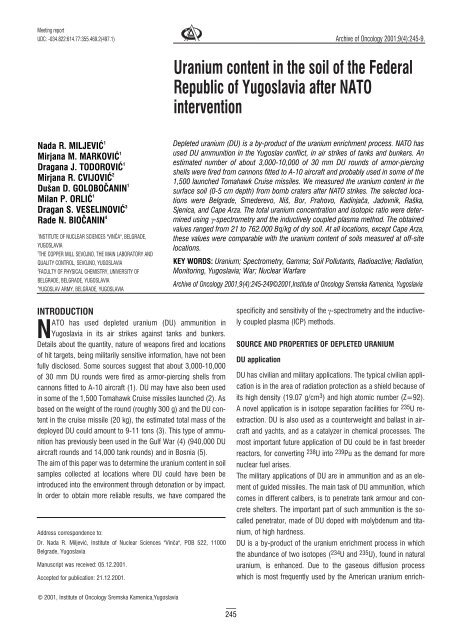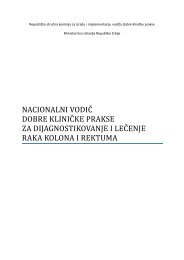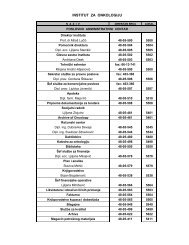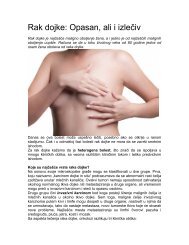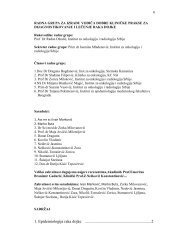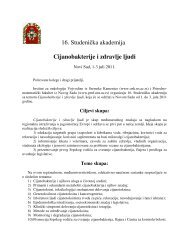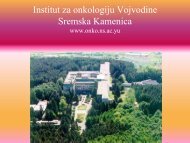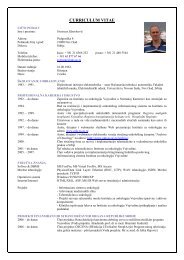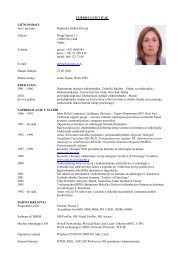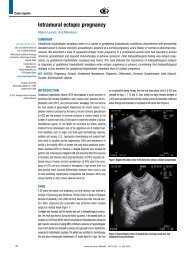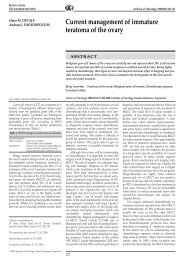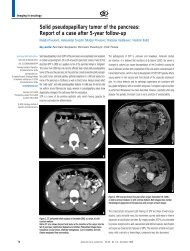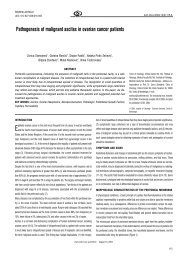Uranium content in the soil of the Federal Republic of Yugoslavia ...
Uranium content in the soil of the Federal Republic of Yugoslavia ...
Uranium content in the soil of the Federal Republic of Yugoslavia ...
You also want an ePaper? Increase the reach of your titles
YUMPU automatically turns print PDFs into web optimized ePapers that Google loves.
Meet<strong>in</strong>g report<br />
UDC: -034.822:614.77:355.469.2(497.1)<br />
Archive <strong>of</strong> Oncology 2001;9(4):245-9.<br />
<strong>Uranium</strong> <strong>content</strong> <strong>in</strong> <strong>the</strong> <strong>soil</strong> <strong>of</strong> <strong>the</strong> <strong>Federal</strong><br />
<strong>Republic</strong> <strong>of</strong> <strong>Yugoslavia</strong> after NATO<br />
<strong>in</strong>tervention<br />
Nada R. MILJEVIÆ 1<br />
Mirjana M. MARKOVIÆ 1<br />
Dragana J. TODOROVIÆ 1<br />
Mirjana R. CVIJOVIÆ 2<br />
Du¹an D. GOLOBOÈANIN 1<br />
Milan P. ORLIÆ 1<br />
Dragan S. VESELINOVIÆ 3<br />
Rade N. BIOÈANIN 4<br />
1<br />
INSTITUTE OF NUCLEAR SCIENCES "VINÈA", BELGRADE,<br />
YUGOSLAVIA<br />
2<br />
THE COPPER MILL SEVOJNO, THE MAIN LABORATORY AND<br />
QUALITY CONTROL, SEVOJNO, YUGOSLAVIA<br />
3<br />
FACULTY OF PHYSICAL CHEMISTRY, UNIVERSITY OF<br />
BELGRADE, BELGRADE, YUGOSLAVIA<br />
4<br />
YUGOSLAV ARMY, BELGRADE, YUGOSLAVIA<br />
Depleted uranium (DU) is a by-product <strong>of</strong> <strong>the</strong> uranium enrichment process. NATO has<br />
used DU ammunition <strong>in</strong> <strong>the</strong> Yugoslav conflict, <strong>in</strong> air strikes <strong>of</strong> tanks and bunkers. An<br />
estimated number <strong>of</strong> about 3,000-10,000 <strong>of</strong> 30 mm DU rounds <strong>of</strong> armor-pierc<strong>in</strong>g<br />
shells were fired from cannons fitted to A-10 aircraft and probably used <strong>in</strong> some <strong>of</strong> <strong>the</strong><br />
1,500 launched Tomahawk Cruise missiles. We measured <strong>the</strong> uranium <strong>content</strong> <strong>in</strong> <strong>the</strong><br />
surface <strong>soil</strong> (0-5 cm depth) from bomb craters after NATO strikes. The selected locations<br />
were Belgrade, Smederevo, Ni¹, Bor, Prahovo, Kad<strong>in</strong>jaèa, Jadovnik, Ra¹ka,<br />
Sjenica, and Cape Arza. The total uranium concentration and isotopic ratio were determ<strong>in</strong>ed<br />
us<strong>in</strong>g g-spectrometry and <strong>the</strong> <strong>in</strong>ductively coupled plasma method. The obta<strong>in</strong>ed<br />
values ranged from 21 to 762.000 Bq/kg <strong>of</strong> dry <strong>soil</strong>. At all locations, except Cape Arza,<br />
<strong>the</strong>se values were comparable with <strong>the</strong> uranium <strong>content</strong> <strong>of</strong> <strong>soil</strong>s measured at <strong>of</strong>f-site<br />
locations.<br />
KEY WORDS: <strong>Uranium</strong>; Spectrometry, Gamma; Soil Pollutants, Radioactive; Radiation,<br />
Monitor<strong>in</strong>g, <strong>Yugoslavia</strong>; War; Nuclear Warfare<br />
Archive <strong>of</strong> Oncology 2001,9(4):245-249©2001,Institute <strong>of</strong> Oncology Sremska Kamenica, <strong>Yugoslavia</strong><br />
INTRODUCTION<br />
ATO has used depleted uranium (DU) ammunition <strong>in</strong><br />
N<strong>Yugoslavia</strong> <strong>in</strong> its air strikes aga<strong>in</strong>st tanks and bunkers.<br />
Details about <strong>the</strong> quantity, nature <strong>of</strong> weapons fired and locations<br />
<strong>of</strong> hit targets, be<strong>in</strong>g militarily sensitive <strong>in</strong>formation, have not been<br />
fully disclosed. Some sources suggest that about 3,000-10,000<br />
<strong>of</strong> 30 mm DU rounds were fired as armor-pierc<strong>in</strong>g shells from<br />
cannons fitted to A-10 aircraft (1). DU may have also been used<br />
<strong>in</strong> some <strong>of</strong> <strong>the</strong> 1,500 Tomahawk Cruise missiles launched (2). As<br />
based on <strong>the</strong> weight <strong>of</strong> <strong>the</strong> round (roughly 300 g) and <strong>the</strong> DU <strong>content</strong><br />
<strong>in</strong> <strong>the</strong> cruise missile (20 kg), <strong>the</strong> estimated total mass <strong>of</strong> <strong>the</strong><br />
deployed DU could amount to 9-11 tons (3). This type <strong>of</strong> ammunition<br />
has previously been used <strong>in</strong> <strong>the</strong> Gulf War (4) (940,000 DU<br />
aircraft rounds and 14,000 tank rounds) and <strong>in</strong> Bosnia (5).<br />
The aim <strong>of</strong> this paper was to determ<strong>in</strong>e <strong>the</strong> uranium <strong>content</strong> <strong>in</strong> <strong>soil</strong><br />
samples collected at locations where DU could have been be<br />
<strong>in</strong>troduced <strong>in</strong>to <strong>the</strong> environment through detonation or by impact.<br />
In order to obta<strong>in</strong> more reliable results, we have compared <strong>the</strong><br />
Address correspondence to:<br />
Dr. Nada R. Miljeviæ, Institute <strong>of</strong> Nuclear Sciences "V<strong>in</strong>èa", POB 522, 11000<br />
Belgrade, <strong>Yugoslavia</strong><br />
Manuscript was received: 05.12.2001.<br />
Accepted for publication: 21.12.2001.<br />
specificity and sensitivity <strong>of</strong> <strong>the</strong> g-spectrometry and <strong>the</strong> <strong>in</strong>ductively<br />
coupled plasma (ICP) methods.<br />
SOURCE AND PROPERTIES OF DEPLETED URANIUM<br />
DU application<br />
DU has civilian and military applications. The typical civilian application<br />
is <strong>in</strong> <strong>the</strong> area <strong>of</strong> radiation protection as a shield because <strong>of</strong><br />
its high density (19.07 g/cm 3 ) and high atomic number (Z=92).<br />
A novel application is <strong>in</strong> isotope separation facilities for 235 U reextraction.<br />
DU is also used as a counterweight and ballast <strong>in</strong> aircraft<br />
and yachts, and as a catalyzer <strong>in</strong> chemical processes. The<br />
most important future application <strong>of</strong> DU could be <strong>in</strong> fast breeder<br />
reactors, for convert<strong>in</strong>g 238 U <strong>in</strong>to 239 Pu as <strong>the</strong> demand for more<br />
nuclear fuel arises.<br />
The military applications <strong>of</strong> DU are <strong>in</strong> ammunition and as an element<br />
<strong>of</strong> guided missiles. The ma<strong>in</strong> task <strong>of</strong> DU ammunition, which<br />
comes <strong>in</strong> different calibers, is to penetrate tank armour and concrete<br />
shelters. The important part <strong>of</strong> such ammunition is <strong>the</strong> socalled<br />
penetrator, made <strong>of</strong> DU doped with molybdenum and titanium,<br />
<strong>of</strong> high hardness.<br />
DU is a by-product <strong>of</strong> <strong>the</strong> uranium enrichment process <strong>in</strong> which<br />
<strong>the</strong> abundance <strong>of</strong> two isotopes ( 234 U and 235 U), found <strong>in</strong> natural<br />
uranium, is enhanced. Due to <strong>the</strong> gaseous diffusion process<br />
which is most frequently used by <strong>the</strong> American uranium enrich-<br />
© 2001, Institute <strong>of</strong> Oncology Sremska Kamenica,<strong>Yugoslavia</strong><br />
245
Miljeviæ R.N.<br />
ment companies, <strong>the</strong> US Department <strong>of</strong> Energy is currently <strong>in</strong><br />
possession <strong>of</strong> a stockpile <strong>of</strong> about 734,000 metric tons <strong>of</strong> DU<br />
hexafluoride (6), with a production rate <strong>of</strong> about 1,900 metric<br />
tons/y. Its high density (19.05 g/cm 3 ) and low cost make it readily<br />
available for military munitions and for civil purposes, as aircraft<br />
counterweights (7), shield<strong>in</strong>g <strong>in</strong> some medical equipment,<br />
and ballast where volume constra<strong>in</strong>ts prohibit <strong>the</strong> use <strong>of</strong> less<br />
dense metals. DU was also placed <strong>in</strong> <strong>the</strong> tips <strong>of</strong> <strong>the</strong> BGM-109<br />
Tomahawk land-attack cruise missiles (TLAM) dur<strong>in</strong>g test flights,<br />
to provide weight and stability (8). The caliber <strong>of</strong> DU penetrators<br />
<strong>in</strong> <strong>the</strong> US arsenal lies <strong>in</strong> <strong>the</strong> range between 20 and 120 mm (9).<br />
The Nuclear Regulatory Commission def<strong>in</strong>es DU as uranium <strong>in</strong><br />
which <strong>the</strong> <strong>content</strong> <strong>of</strong> <strong>the</strong> 235 U isotope is below than 0.72%, while<br />
<strong>the</strong> military specifications designate that DU used by <strong>the</strong><br />
Department <strong>of</strong> Defense (DoD) conta<strong>in</strong>s less than 0.3% <strong>of</strong> 235 U.<br />
Actually, <strong>the</strong> DoD uses only DU conta<strong>in</strong><strong>in</strong>g approximately 0.2% <strong>of</strong><br />
235 U (10).<br />
Properties <strong>of</strong> depleted uranium<br />
DU is both radioactive and toxic. Its total activity is 22% less than,<br />
and its a-activity is 43% <strong>of</strong> that <strong>of</strong> <strong>the</strong> natural mixture <strong>of</strong> uranium<br />
isotopes. The specific activity <strong>of</strong> DU with daughter products is<br />
39.42 MBq/kg while its a-activity is 14.4 MBq/kg. It emits relatively<br />
strong b-radiation (E max =2.29 MeV from 234m Pa) and<br />
extremely low gamma emission (0.048 MeV) from most <strong>of</strong> <strong>the</strong> six<br />
decay products.<br />
When a DU bullet impacts a hard object (armour or rock), it is<br />
crushed <strong>in</strong>to fragments, burned (18-70%) and oxidized <strong>in</strong>to dust.<br />
<strong>Uranium</strong> oxides (U 3 O 8 , UO 2 and UO 3 ) are be<strong>in</strong>g formed. The latter<br />
oxide is <strong>the</strong> only one soluble <strong>in</strong> water, form<strong>in</strong>g uranyl (UO 2 ) 2+<br />
ions. The oxide aerosol result<strong>in</strong>g from impact has 50-96% <strong>of</strong> respirable-size<br />
particles (diameter less than 10 (m) with air concentrations<br />
5-780 mg/m 3 (a-activity <strong>of</strong> 0.07-11.1 kBq/m 3 ), and 17-<br />
48% <strong>of</strong> <strong>the</strong>se particles is soluble <strong>in</strong> water. The o<strong>the</strong>r particles<br />
become attached to <strong>soil</strong> particles by melt<strong>in</strong>g <strong>of</strong> <strong>the</strong> <strong>soil</strong> and form<br />
a silicate glass. If <strong>the</strong> penetrator hits s<strong>of</strong>t ground (sand or clay), it<br />
will penetrate <strong>the</strong> <strong>soil</strong> (to a depth <strong>of</strong> over 50 cm) and rema<strong>in</strong> <strong>the</strong>re<br />
for long time. Studies <strong>of</strong> DU penetrator wea<strong>the</strong>r<strong>in</strong>g have shown<br />
that <strong>the</strong>y pr<strong>in</strong>cipally corrode <strong>in</strong>to hydrated U(VI) oxides which are<br />
very soluble <strong>in</strong> water (11). The ma<strong>in</strong> pathway affect<strong>in</strong>g human<br />
health is <strong>in</strong>halation <strong>of</strong> <strong>in</strong>soluble DU dust and <strong>in</strong>halation or <strong>in</strong>gestion<br />
<strong>of</strong> its soluble component.<br />
Investigations <strong>of</strong> <strong>the</strong> migration <strong>of</strong> DU and its transport, follow<strong>in</strong>g<br />
dynamic weapons test<strong>in</strong>g operations <strong>in</strong> both semi-arid (Los<br />
Alamos National Laboratory site, New Mexico, 510 mm annual<br />
ra<strong>in</strong>fall) and humid (Egl<strong>in</strong> Air Force Base, Florida, 1650 mm annual<br />
ra<strong>in</strong>fall) environments could be useful <strong>in</strong> develop<strong>in</strong>g a strategy<br />
for obta<strong>in</strong><strong>in</strong>g representative samples (12). Assesments <strong>of</strong> <strong>the</strong><br />
total uranium <strong>content</strong> from 750 site measurements (13) <strong>of</strong><br />
atmospheric fallout, <strong>soil</strong>, sediment, water and suspended sediments<br />
collected <strong>in</strong> <strong>the</strong> time period 1983-1990, related to background<br />
concentrations (14) have shown that about 90% <strong>of</strong> <strong>the</strong><br />
uranium rema<strong>in</strong>ed <strong>in</strong> <strong>the</strong> proximity <strong>of</strong> <strong>the</strong> fir<strong>in</strong>g sites and 10%<br />
entered <strong>the</strong> watershed. Investigations were conf<strong>in</strong>ed to one watershed<br />
called <strong>the</strong> Potrillo Canyon, <strong>of</strong> small size (5 km 2 ), and with<br />
no public access. A conservative estimate <strong>of</strong> <strong>the</strong> total uranium<br />
source was about 35 tons. These results could be used to develop<br />
<strong>the</strong> follow<strong>in</strong>g guidel<strong>in</strong>es <strong>in</strong> <strong>the</strong> detection <strong>of</strong> uranium around <strong>the</strong><br />
impact po<strong>in</strong>ts:<br />
1. The concentration <strong>in</strong> <strong>soil</strong>s and sediments decreases with<br />
<strong>in</strong>creas<strong>in</strong>g distance from <strong>the</strong> fir<strong>in</strong>g sites<br />
2. The greatest concentration is to be found <strong>in</strong> transported suspended<br />
sediments carried <strong>in</strong> run<strong>of</strong>f waters, followed by sediment<br />
present <strong>in</strong> stream banks,<br />
3. The concentration <strong>in</strong> run<strong>of</strong>f, <strong>in</strong> <strong>the</strong> dissolved and suspended<br />
sediment phases, decl<strong>in</strong>es with downstream direction <strong>in</strong> <strong>the</strong><br />
watershed,<br />
4. <strong>Uranium</strong> moves vertically <strong>in</strong>to <strong>the</strong> <strong>soil</strong> pr<strong>of</strong>ile at regions close<br />
to <strong>the</strong> fir<strong>in</strong>g site with <strong>the</strong> largest concentrations <strong>in</strong> <strong>the</strong> upper 5cm<br />
<strong>of</strong> <strong>soil</strong>, about 30 times higher than at 5-10 cm depth,<br />
5. <strong>Uranium</strong> is readily leached <strong>in</strong>to <strong>the</strong> dissolved phase, <strong>of</strong>ten with<strong>in</strong><br />
a few hours, which is <strong>the</strong> time frame <strong>of</strong> most ra<strong>in</strong>fall events,<br />
6. <strong>Uranium</strong> concentration <strong>in</strong>creases with decreas<strong>in</strong>g particle size,<br />
hav<strong>in</strong>g a particular aff<strong>in</strong>ity to f<strong>in</strong>e slits and clays.<br />
Measurement <strong>of</strong> DU<br />
There are three types <strong>of</strong> measurements concern<strong>in</strong>g <strong>the</strong> environmental<br />
impact <strong>of</strong> DU: territorial survey; measurements <strong>of</strong> samples<br />
<strong>of</strong> <strong>soil</strong>, water, air and food; and measurements <strong>in</strong> human body<br />
and excreta.<br />
Figure 1. Depleted uranium ammunition caliber 30 mm external exposure <strong>of</strong><br />
whole penetrator<br />
The terra<strong>in</strong> is surveyed to rapidly locate sites where DU has been<br />
deposited. Survey<strong>in</strong>g is performed on <strong>the</strong> basis <strong>of</strong> measurements<br />
<strong>of</strong> ioniz<strong>in</strong>g radiation. The most appropriate <strong>in</strong>struments, such as<br />
th<strong>in</strong>-w<strong>in</strong>dow GM counters or sc<strong>in</strong>tillation detectors, have to detect<br />
© 2001, Institute <strong>of</strong> Oncology Sremska Kamenica,<strong>Yugoslavia</strong><br />
246
<strong>Uranium</strong> <strong>content</strong> <strong>in</strong> <strong>the</strong> <strong>soil</strong> after NATO <strong>in</strong>tervention<br />
beta and gamma radiation. Dur<strong>in</strong>g <strong>the</strong> measurement <strong>the</strong> detectors<br />
have to be as close as possible to <strong>the</strong> ground. Even <strong>in</strong> that case<br />
it is very difficult to f<strong>in</strong>d <strong>the</strong> correct localisation. It is necessary to<br />
know <strong>the</strong> approximate location <strong>in</strong>dependently. As an example, <strong>the</strong><br />
dose rate around a complete 30 mm caliber penetrator as a function<br />
<strong>of</strong> distance from <strong>the</strong> penetrator, is presented <strong>in</strong> Figure 1.<br />
The radiological consequences <strong>of</strong> DU <strong>in</strong> humans can only be<br />
estimated by <strong>the</strong> effective dose from external or <strong>in</strong>ternal sources.<br />
To calculate dose from <strong>in</strong>ternal sources, apply<strong>in</strong>g respective conversion<br />
coefficients, it is necessary to measure <strong>the</strong> concentration<br />
<strong>of</strong> DU on <strong>the</strong> ground surface, <strong>in</strong> air, water, food and <strong>the</strong> human<br />
body. These measurements are based on samples <strong>of</strong> ground,<br />
food, water, air and excreta and can be performed only <strong>in</strong> specialized<br />
laboratories. There are two types <strong>of</strong> such measurements:<br />
nuclear (X, gamma and alpha spectrometry, neutron activation<br />
analysis, whole body counter) and non-nuclear (mass spectrometry).<br />
Suitable preparation <strong>of</strong> samples is essential for all <strong>the</strong> above<br />
methods. The preparation can be very simple (gamma spectrometry)<br />
or more complicated (alpha spectrometry). Neutron activation<br />
analysis is <strong>the</strong> most sensitive method, but it is quite expensive,<br />
as it requires neutron sources, such as nuclear reactors.<br />
DU activity or concentration measurements <strong>in</strong> air are performed<br />
<strong>in</strong>directly by flow<strong>in</strong>g large amounts <strong>of</strong> air through appropriate filters.<br />
These filters become sources <strong>of</strong> alpha, beta and gamma<br />
rays for fur<strong>the</strong>r analysis us<strong>in</strong>g <strong>the</strong> above-described methods.<br />
Health effects <strong>of</strong> DU may result from its chemo- and radiotoxicity.<br />
Chemotoxicity could be <strong>the</strong> dom<strong>in</strong>ant effect <strong>in</strong> <strong>the</strong> immediate<br />
vic<strong>in</strong>ity <strong>of</strong> <strong>the</strong> impact location. At larger distances both effects<br />
become negligible.<br />
<strong>Uranium</strong> natural background concentrations<br />
The <strong>content</strong> and activity <strong>of</strong> uranium <strong>in</strong> <strong>the</strong> environment are quite<br />
variable, as presented <strong>in</strong> Table 1.<br />
Table 1. <strong>Uranium</strong> <strong>content</strong> <strong>in</strong> <strong>the</strong> environment<br />
The geological structure <strong>of</strong> Serbia's territory <strong>in</strong>cludes igneous<br />
rocks, such as granodiorite, crystall<strong>in</strong>e shales and Neogene volcanices<br />
with an uranium <strong>content</strong> <strong>of</strong> up to 4.4 mg/kg (15). The<br />
scatter<strong>in</strong>g <strong>of</strong> ore refuses from <strong>the</strong> Kalna-Gabrovica uranium m<strong>in</strong>e<br />
has enriched its U <strong>content</strong> (7.7 -28.1 mg/kg) <strong>in</strong> <strong>the</strong> barren <strong>soil</strong><br />
deposit, with an average concentration <strong>of</strong> 17 mg/kg (as based on<br />
32 samples) (16). As a result <strong>of</strong> widespread application <strong>of</strong> phosphate<br />
fertilizers (P-fert) with a very significant uranium concentration<br />
(30-300 mg/kg), <strong>the</strong> uranium concentration <strong>in</strong> Serbian<br />
<strong>soil</strong>s currently ranges between 0.08 and 5.9 mg/kg (17).<br />
EXPERIMENTAL<br />
Sampl<strong>in</strong>g<br />
Soil samples were collected from bomb craters <strong>in</strong> June, based on<br />
<strong>in</strong>formation on <strong>the</strong>se craters be<strong>in</strong>g caused by NATO Cruise missiles<br />
<strong>in</strong> April and May 1999. The selected locations were<br />
Belgrade, Smederevo, Ni¹, Bor, Prahovo, Kad<strong>in</strong>jaèa, Jadovnik,<br />
Ra¹ka, Sjenica, and Cape Arza on <strong>the</strong> Lustica pen<strong>in</strong>sula. In addition,<br />
at a distance at least <strong>of</strong> two kilometers from <strong>the</strong> <strong>in</strong>vestigated<br />
craters, samples were ga<strong>the</strong>red to assess <strong>the</strong> uranium <strong>content</strong>, <strong>in</strong><br />
order to obta<strong>in</strong> a reference measurement <strong>of</strong> background uranium<br />
concentration. Soil sampl<strong>in</strong>g consists <strong>of</strong> randomly taken shallow<br />
scoops <strong>of</strong> surface <strong>soil</strong> (0-5 cm depth, order <strong>of</strong> 1 m 2 ), after<br />
remov<strong>in</strong>g stones or clean<strong>in</strong>g <strong>the</strong> surface vegetation from <strong>the</strong> site.<br />
Soil samples were wrapped <strong>in</strong> plastic bags and brought to <strong>the</strong> laboratory.<br />
<strong>Uranium</strong> analysis<br />
We used g-spectrometry to directly measure gamma emitters <strong>in</strong><br />
<strong>soil</strong> samples (18). After air-dry<strong>in</strong>g and mix<strong>in</strong>g <strong>the</strong> sample, an<br />
aliquot was removed for analysis. Each sample was weighed and<br />
stored <strong>in</strong> a sealed polyethylene conta<strong>in</strong>er (50 g) or Mar<strong>in</strong>elli<br />
beaker (500 g capacity) for a 40-day period. The analyses were<br />
carried out us<strong>in</strong>g Canberra HP Ge coaxial detectors (models<br />
GC1318-7500 and GC2018-7500) hav<strong>in</strong>g a relative efficiency <strong>of</strong><br />
14.7% and 23%, energy resolution <strong>of</strong> 1.7 keV and 1.8 keV,<br />
respectively <strong>of</strong> <strong>the</strong> 1332 keV l<strong>in</strong>e from 60 Co. The background<br />
count rate was 0.560 cps <strong>in</strong> <strong>the</strong> 20-2900 keV energy <strong>in</strong>terval. The<br />
concentration <strong>of</strong> 238 U and 235 U was determ<strong>in</strong>ed via <strong>the</strong> photopeaks<br />
emitted by <strong>the</strong>ir daughters: 234 Th (63 keV) and 235 U (185<br />
keV), respectively. The total relative errors for activity measurements<br />
ranged between 26 and 85%. The count<strong>in</strong>g time for each<br />
sample was 86.000 s, background be<strong>in</strong>g measured over a longer<br />
period. The efficiency for <strong>the</strong> sample count<strong>in</strong>g configuration was<br />
determ<strong>in</strong>ed with standard <strong>soil</strong> samples (Standard Reference<br />
Material 694, National Bureau <strong>of</strong> Standards, Budapest) conta<strong>in</strong><strong>in</strong>g<br />
a known mixture <strong>of</strong> n<strong>in</strong>e radionuclides.<br />
As an alternative, <strong>the</strong> technique <strong>of</strong> ICP/OES (ARL model 3580)<br />
was employed. A representative sample <strong>of</strong> <strong>soil</strong> was air-dried and<br />
ground <strong>in</strong> a mill to become homogenized. A 10 g portion <strong>of</strong> <strong>the</strong> 3<br />
mm-sieved sample was placed <strong>in</strong> a high temperature furnace<br />
(550 o C) overnight, to remove <strong>the</strong> organic components. The sample<br />
was <strong>the</strong>n treated with concentrated HNO 3 /HCl <strong>in</strong> a plat<strong>in</strong>um<br />
crucible, followed by dilution and filtration (19). Digestion <strong>of</strong> <strong>the</strong><br />
residue was repeated 2-3 times until it became gray-white <strong>in</strong><br />
colour, <strong>in</strong> order to yield <strong>the</strong> sample solutions. Measurements<br />
© 2001, Institute <strong>of</strong> Oncology Sremska Kamenica,<strong>Yugoslavia</strong><br />
247
Miljeviæ R.N.<br />
were made with standard addition <strong>of</strong> uranyl nitrate. Standard solutions<br />
were prepared and used to obta<strong>in</strong> <strong>the</strong> calibration curve.<br />
Standard reference materials were used to validate <strong>the</strong> analytical<br />
procedure. Decomposition and analysis were duplicated for each<br />
sample. The range <strong>of</strong> <strong>the</strong> relative standard deviation was 3-7%.<br />
RESULTS AND DISCUSSION<br />
The primary objective <strong>of</strong> this survey was to locate <strong>the</strong> deployed<br />
DU. As <strong>the</strong>re were practically no data on <strong>the</strong> levels <strong>of</strong> uranium <strong>in</strong><br />
<strong>the</strong> environment around <strong>the</strong> analyzed locations, undisturbed <strong>soil</strong><br />
samples were taken to obta<strong>in</strong> natural background measurements.<br />
A prelim<strong>in</strong>ary judgement <strong>of</strong> <strong>the</strong> most likely amount <strong>of</strong> uranium<br />
deposited on <strong>the</strong> ground could be made assum<strong>in</strong>g that dur<strong>in</strong>g one<br />
A-10 aircraft engagement 50-100 rounds are fired and that one <strong>of</strong><br />
every five bullets conta<strong>in</strong>s DU (20). Usually, three attack planes<br />
work toge<strong>the</strong>r aga<strong>in</strong>st a target and <strong>the</strong> amount <strong>of</strong> DU <strong>in</strong> <strong>the</strong> area<br />
hit (20x50=1000 m 2 ) might be 9-18 kg. If 10 kg <strong>of</strong> DU were<br />
spread, tak<strong>in</strong>g <strong>in</strong>to consideration <strong>soil</strong> depth <strong>of</strong> 5mm and specific<br />
gravity <strong>of</strong> 1.5 g/cm 3 , <strong>the</strong> uranium concentration <strong>of</strong> <strong>the</strong> <strong>soil</strong> would<br />
be estimated to be about 1300 mg/kg. A similar evaluation could<br />
be made for <strong>the</strong> cruise missile that conta<strong>in</strong>s DU. The dom<strong>in</strong>ant<br />
mechanism for uranium redistribution is <strong>the</strong> surface water pathway<br />
and due to <strong>the</strong> high ra<strong>in</strong>fall, which had occurred <strong>in</strong> June 1999<br />
(up to 30-40 l/m 2 per day) (21), <strong>the</strong> result<strong>in</strong>g concentration,<br />
might be low, much less than assumed. Although <strong>the</strong> estimation<br />
is very rough and would apply only for <strong>the</strong> immediate vic<strong>in</strong>ity <strong>of</strong><br />
<strong>the</strong> target, it is suggested that <strong>the</strong> excess uranium <strong>in</strong> <strong>the</strong> surface<br />
<strong>soil</strong>s would have a ra<strong>the</strong>r low enrichment. Therefore, <strong>the</strong> choice<br />
<strong>of</strong> <strong>the</strong> correct analytic method it is very important for quantitative<br />
analysis <strong>of</strong> DU concentration.<br />
The results <strong>of</strong> our field <strong>in</strong>vestigation are summarized <strong>in</strong> Table 2,<br />
along with <strong>the</strong> description <strong>of</strong> <strong>the</strong> <strong>soil</strong>'s orig<strong>in</strong>. The <strong>in</strong>dividual isotopic<br />
uranium activity ( 238 U) as well as <strong>the</strong> 235 U/ 238 U isotopic<br />
ratio are given. The concentrations <strong>in</strong> <strong>the</strong> surface <strong>soil</strong> (0-5 cm <strong>in</strong><br />
depth) range from 1.7 to 14 mg 238 U/kg dry <strong>soil</strong> and up to 22<br />
Table 2. <strong>Uranium</strong> <strong>content</strong> and its isotopic ratio <strong>in</strong> <strong>the</strong> <strong>in</strong>vestigated <strong>soil</strong>s<br />
mg/kg <strong>of</strong> total uranium. The obta<strong>in</strong>ed isotope ratio from 0.0071 to<br />
0.0075 corresponds to natural uranium abundance (0.00725) at<br />
most locations. In contrast, high values, between 0.0161 and<br />
0.0085, were recorded for <strong>soil</strong> samples taken from bomb craters<br />
<strong>in</strong> Jadovnik, Ra¹ka, and Sjenica. It is worth mention<strong>in</strong>g that a relatively<br />
high ratio <strong>of</strong> 0.0105 was found <strong>in</strong> undisturbed <strong>soil</strong> on<br />
Jadovnik where we expected a control value. These markedly<br />
higher ratios could be expla<strong>in</strong>ed ra<strong>the</strong>r by high count<strong>in</strong>g errors<br />
(45-85%) than by any excess <strong>of</strong> non-natural uranium. On <strong>the</strong><br />
o<strong>the</strong>r hand, <strong>the</strong> errors <strong>of</strong> measur<strong>in</strong>g <strong>the</strong> 238 U <strong>content</strong> for samples<br />
conta<strong>in</strong>g high activity from <strong>the</strong> Cape Arza location were small<br />
(about 7%). The obta<strong>in</strong>ed isotope ratios <strong>of</strong> 0.0011 <strong>in</strong> those samples<br />
<strong>in</strong>dicate that a DU weapon was used at this site.<br />
For comparison, Table 3. lists <strong>the</strong> total uranium concentration<br />
obta<strong>in</strong>ed by g-spectrometry (measured 238 U concentration data,<br />
comb<strong>in</strong>ed with <strong>the</strong> 235 U/ 238 U ratio assum<strong>in</strong>g that 234 U and 236 U<br />
have negligible concentration), and <strong>the</strong> results obta<strong>in</strong>ed with <strong>the</strong><br />
ICP method. Good agreement between data obta<strong>in</strong>ed from undisturbed<br />
locations at Kad<strong>in</strong>jaèa and Jadovnik is evident. The reason<br />
for <strong>the</strong> significant difference between two correspond<strong>in</strong>g samples<br />
taken at o<strong>the</strong>r locations is probably due to <strong>in</strong>terference from Si,<br />
Ca, Fe, and Al (22).<br />
Table 3. Results <strong>of</strong> total uranium concentration by g-spectrometry and <strong>in</strong>ductively<br />
coupled plasma<br />
To confirm <strong>the</strong>se results a more advanced method with higher<br />
analytical precision, such as <strong>the</strong>rmal ionization mass spectrometry<br />
us<strong>in</strong>g isotope dilution spike, should be applied (23). It is reasonable<br />
to suppose that <strong>the</strong> isotopic analysis can uniquely dist<strong>in</strong>guish<br />
contam<strong>in</strong>ation by uranium from <strong>in</strong>digenous uranium present<br />
at background level.<br />
CONCLUSION<br />
The presence <strong>of</strong> DU is difficult to detect directly <strong>in</strong> <strong>the</strong> environment<br />
unless <strong>the</strong> concentration is significantly above background.<br />
The wide range <strong>of</strong> uranium <strong>content</strong> <strong>in</strong> <strong>the</strong> <strong>soil</strong>s (2-22 mg/kg) at<br />
<strong>the</strong> studied locations is due to <strong>the</strong> different type <strong>of</strong> <strong>soil</strong>, <strong>soil</strong> formation<br />
and <strong>soil</strong> transport process (geological orig<strong>in</strong>). The<br />
obta<strong>in</strong>ed values are comparable with those for undisturbed <strong>soil</strong>s,<br />
<strong>in</strong>dicat<strong>in</strong>g that <strong>the</strong>re was no presence <strong>of</strong> DU at <strong>the</strong>se sites with<strong>in</strong><br />
measurement error limits. Only once could deployment <strong>of</strong> a DU<br />
weapon be stated, at <strong>the</strong> studied Cape Arza location where <strong>the</strong><br />
238 U <strong>content</strong> was between 23 and 61 kg/kg.<br />
© 2001, Institute <strong>of</strong> Oncology Sremska Kamenica,<strong>Yugoslavia</strong><br />
248
<strong>Uranium</strong> <strong>content</strong> <strong>in</strong> <strong>the</strong> <strong>soil</strong> after NATO <strong>in</strong>tervention<br />
REFERENCES<br />
1. Richarson JJ. Depleted <strong>Uranium</strong>. Mo<strong>the</strong>r Jones 23/6/99.<br />
2. Coghill R. The Use <strong>of</strong> DU Bullets and Bombs by NATO Forces <strong>in</strong> <strong>Yugoslavia</strong>,<br />
Coghill Research Laboratories. Available from:<br />
http://www.cogreslab.demon.co.uk (April 1999)<br />
3. Orliæ M, Miljeviæ N. Consequences <strong>of</strong> <strong>the</strong>NATO bomb<strong>in</strong>g <strong>of</strong> <strong>Yugoslavia</strong> related to<br />
<strong>the</strong> use <strong>of</strong> deleted uranium. 17th Conference The '99 Days <strong>of</strong> <strong>the</strong> Institute. In: The<br />
environment and health consequences <strong>of</strong> NATO aggession on <strong>Yugoslavia</strong>,<br />
Belgrade, October 1999. p. 263-71 (<strong>in</strong> Serbian)<br />
4. Health and Environmental Consequences <strong>of</strong> Depleted <strong>Uranium</strong> Use <strong>in</strong> <strong>the</strong> US<br />
Army. US Army Environmental Policy Institute (AEPI); 1995.<br />
5. Ristiæ D, Benderaæ R, Vejnoviæ Z, Orliæ M, Pavloviæ S. NATO Ammunition<br />
Produced from DU Used <strong>in</strong> Bosnian War. V<strong>in</strong>ca Institute <strong>of</strong> Nuclear Sciences<br />
Bullet<strong>in</strong> 1997;4:205 (<strong>in</strong> Serbian).<br />
6. F<strong>in</strong>al Programmatic Environmental Impact Statement for Alternative Strategies<br />
for <strong>the</strong> Long-term Management and Use <strong>of</strong> Depleted <strong>Uranium</strong> Hexafluoride,<br />
DOE/EIS-0269, Department <strong>of</strong> Energy, 1999.<br />
7. Loewenste<strong>in</strong> D. Industrial Uses <strong>of</strong> DU. Vol. I. American Society for metals; 1989.<br />
8. Bukowski G, Lopez DA, McGehee FM. III. <strong>Uranium</strong> Batterfiels Home and Abroad:<br />
DU Use by <strong>the</strong> US Department <strong>of</strong> Defense; Rural Alliance for Military<br />
Accountability, Progressive Alliance for Community Empowerment, Citizen Alert,<br />
1993.<br />
9. Zajic V. Review <strong>of</strong> Radioactivity, Military Use and Health Effects <strong>of</strong> DU, SUC<br />
Report, July1999. Available from: http://members.tripod.com/vzajic<br />
10. Health and Environmental Consequences <strong>of</strong> Depleted <strong>Uranium</strong> Use <strong>in</strong> <strong>the</strong> US<br />
Army. US Army Environmental Policy Institute (AEPI); 1995.<br />
11. Elder JC, T<strong>in</strong>kle MC. Oxidation <strong>of</strong> DU Penentrators and Aerosol Dispersal at High<br />
Temperatures, LA-8610-MS. Los Alamos National Laboratory; 1980.<br />
12. Backer NM, Varta EB. Hydrological Transport <strong>of</strong> DU Associated with Open Air<br />
Dynamic Range Test<strong>in</strong>g at Los Alamos Natural Laboratory, New Mexico and<br />
Egl<strong>in</strong> Air Force Base, Florida, LA-UR-95-1213, LANL, 1995.<br />
13. Becker N, Irv<strong>in</strong>e J. Contam<strong>in</strong>ant signature at Los Alamos Fir<strong>in</strong>g Sites, LA-UR-95-<br />
670, LANL, 1996.<br />
14. Becker NM. Influence <strong>of</strong> hydraulic and geomorphologic components <strong>of</strong> a semiarid<br />
watershed on depleted uranium transport. Ph.D <strong>the</strong>sis. 1991.<br />
15. Jelenkoviæ R. <strong>Uranium</strong> M<strong>in</strong>eralization <strong>in</strong> <strong>the</strong> Sumadija Metallogenic District<br />
(Serbia, <strong>Yugoslavia</strong>): Genetic and Morphostructural Types. Belgrade: <strong>Republic</strong><br />
Fund for Geological Investigation;1991.<br />
16. Stojanoviæ M, Sariæ M, Babiæ M, Ile¹ D. <strong>Uranium</strong> Concentration <strong>in</strong> Pwood Plants<br />
Grow<strong>in</strong>g <strong>in</strong> <strong>the</strong> Vic<strong>in</strong>ity <strong>of</strong> Closed Down <strong>Uranium</strong> M<strong>in</strong>e <strong>in</strong> Kalna: In Proceed<strong>in</strong>gs<br />
I Regional Symposium: Chemistry and <strong>the</strong> Environment, Vrnjacka Banja,<br />
September 25-29, 1995. p.1007-10.<br />
17. Kljajiæ R, ©ipka V, Radenkoviæ M, Mitroviæ R. Coal and Fertilizers as a Source <strong>of</strong><br />
Technologically Enchanted Natural Radioactivity: In Ionization radiation from<br />
nature, JDZZ. V<strong>in</strong>ca Institute <strong>of</strong> Nuclear Sciences; 1995. p. 95-111 (<strong>in</strong> Serbian).<br />
18. Mollah AS, Rahman MM, Husa<strong>in</strong> SR. Distribution <strong>of</strong> g-emitt<strong>in</strong>g Radionuclides <strong>in</strong><br />
Soils at <strong>the</strong> Atomic Energy Research Establishment, Savar, Bangladesh. Health<br />
Phys 1986;50:835.<br />
19. Standard Test Method for Analysis <strong>of</strong> Total and Isotopic <strong>Uranium</strong> and Total<br />
Thorium <strong>in</strong> Soils by Inductively Coupled Plasma-Mass Spectrometry: Annual<br />
Book <strong>of</strong> ASTM Standards 1999;12.01:804-15.<br />
20. The Potential Effects on Human Health and <strong>the</strong> Environment Aris<strong>in</strong>g from<br />
Possible Use <strong>of</strong> Depleted <strong>Uranium</strong> Dur<strong>in</strong>g <strong>the</strong> 1999 Kosovo Conflict: A<br />
Prelim<strong>in</strong>ary Assessment, UNEP/UNCHS Balkans Task Force, October 1999.<br />
21. Hydrometeorological Institute <strong>of</strong> Serbia, personal communication<br />
22. Camis I, Sh<strong>in</strong>n JH. Analysis <strong>of</strong> Beryllium and Depleted <strong>Uranium</strong>: An Overview <strong>of</strong><br />
Detection Methods <strong>in</strong> Aerosols and Soils, LLNL, US Department <strong>of</strong> Energy,<br />
UCID-21400, 1988.<br />
23. Volpe AM, Olivares JA, Murrelli MT. Determ<strong>in</strong>ation <strong>of</strong> Radium Isotope and<br />
Abundances <strong>in</strong> Geologic Samples by Thermal Ionization Mass Spectrometry.<br />
Anal Chem 1991;63:913.<br />
© 2001, Institute <strong>of</strong> Oncology Sremska Kamenica,<strong>Yugoslavia</strong><br />
249


